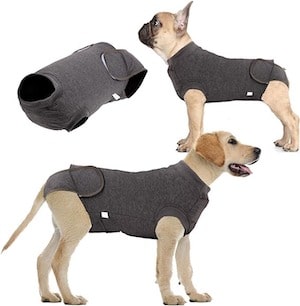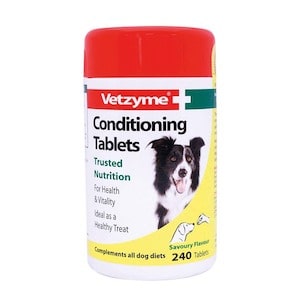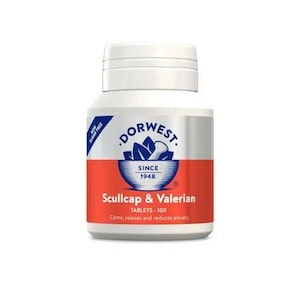A dog c-section or a canine cesarean section is a surgical procedure that is helpful for giving birth to little pups of the dogs. The surgery is useful when natural delivery is not possible or there are certain complications. In general, the c-section is a feasible option in cases of emergencies but, at times vets will suggest going with this surgery to prevent any future pregnancy complications.
The C-section for dogs is an expensive procedure. There are different types of equipment required for conducting the surgery and monitoring the dog’s condition. The medications used during the surgery also add up to these costs. So, it’s obvious to think – how much is a dog c section surgery in the UK?
You Might Also Like:
How Much Is a Dog C Section?
In general, the average cost of c-section surgery for dogs in the UK is about £800. This cost is specific to the active or regular working hours of the hospital or clinic. This means if the surgery is done outside these working hours or if it’s an emergency, the charges can elevate. This timeframe is basically termed emergency hours. So, dog owners should keep this aspect in mind i.e. think of it as double the price.
You may have to roughly pay between £1400–£4000. To understand this high price range, let’s get some insights into this surgical procedure.
C-section in dogs
The procedure is also referred to as hysterotomy. Here a vet will manually get the unborn fetus from the female dog’s uterus instead of a normal vaginal delivery. The female dog’s uterus is cut open for enabling normal and quick delivery of the unborn pup without exerting any pressure.
Here is a simple breakdown of the procedure:
- The pregnant female dog is given anaesthesia
- The uterus is cut open and the unborn pup is taken out
The duration of the surgery is about an hour or an hour and a half. Here are some of the reasons why this procedure is necessary:
- Breed: there are many breeds which cannot stimulate a natural vaginal delivery. These breeds are Bulldog, Scottish Terrier, German Wirehaired, etc. have this issue. A c-section process helps such dogs to get their unborn puppies out.
- Owner’s choice: many owners prefer having a c-section for their dog. The reason for this choice is personal but, often the common reason is the previous pregnancy didn’t go well or they just opt for the surgery this time.
- Emergencies: there are chances of female dogs facing some health emergency or sustaining some sort of injury during their pregnancy. In such cases, the vet may suggest operating on the fetus to ensure their safety.
Emergency Cases where a C-section is necessary
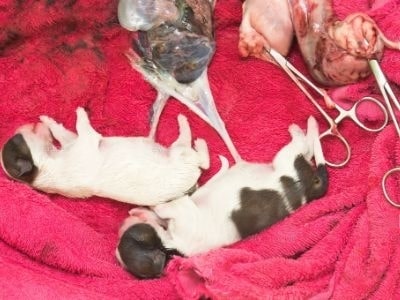
There are many situations where your furry friend will exhibit signs of healthy and normal pregnancy but, will have difficulty in delivering the baby pups. Hence, it’s crucial to know about such emergency situations so that you can take the necessary steps and avoid any severe issues. Below are such cases where the procedure becomes a necessity:
#1 Internal bleeding and infection
If your furry friend is producing unusual vaginal discharge it’s a sign of internal complication. The colour of the discharge will remain either yellowish, greenish, black, bloody, or pus-like. This indicates infection or bleeding and a c-section will become necessary to save the lives of the puppies inside.
#2 Long past the due date
At times, the dog may not give birth at the estimated due date. In such cases, vets use medication for stimulating uterine contraction, when this method fails they will proceed with a c-section for the safety of both mother dog and puppies.
#3 Difficulty in Labour (giving birth)
Sometimes there is no health issue with the dog, no internal bleeding, or any sort of infection but, they have difficulty in labour. Some female dogs face extreme pain and this issue often leads to neonatal death of puppies. This condition is also known as dystocia and is triggered because of a variety of issues. Some of these issues are:
- The dam is going through labour continuously without delivering any puppies.
- A big puppy is stuck in the birth canal because of excessive labour.
- The female dog has given birth to a couple of puppies, but still, there are a few pups left inside.
- A fetus is in the wrong position, like sideways and this stops the passage through the birth canal.
#4 Narrow hips
The narrow hips of dogs can cause issues while delivering a pup with a big head. The irregularity in the shape of the head makes it tough for the mother dog to push through and they may get stuck. So, in such cases, a c-section is a must and dog breeds like bulldogs who have bulky heads, are prone to have this problem.
#5 Uterine inertia
When the muscles of the uterus are weak and are not able to contract in order to allow the puppies pushed out, it is referred to as uterine inertia. This issue delays the birth and hence a c-section is necessary.
#6 Breed
There are many breeds which have difficulty giving birth naturally. The reason behind this issue is the physical structure. These breeds have a broad head and narrow pelvis which makes it tough for them to give birth without the c-section procedure.
English Bulldogs, Boston Terriers, Chihuahuas, and French Bulldogs are some of the breeds that need c-section procedures for giving birth. In fact, some large breed dogs such as German shepherds and Mastiffs also require this surgical procedure.
C-section Surgery For Dogs
We have a rough idea that a c-section surgery will last for half an hour but, there are many aspects to consider for the successful execution and avoid any major complications. Here are some of these aspects:
- Pre-surgery formalities and examination
May seem irrelevant but, is crucial. You will fill in the paperwork for the process and pay the fees on arrival and get a slot within working hours. A vet will conduct a physical examination, analyse different test reports and determine whether the dog’s surgery is an option or not.
- Diagnosis
Your veterinarian will probably conduct digital vaginal palpation to evaluate maternal pelvic anomalies and the size of the fetus. In addition, they will also make an attempt at manual removal without surgery. But, if the puppies are too large or the pelvic canal too narrow for passage, they will suggest a c-section.
Further, the vet will examine abdominal radiograph reports. This will provide to evaluate the size, location, and number of puppies in the uterus. An abdominal ultrasound examination is also done to consider the viability of the puppies. If these tests suggest that the puppies are too big or are in pain, the vet will prep for an emergency cesarean.
- Anaesthesia
The anaesthesia is given to the dam (pregnant female dog) to put them down to sleep. A medical professional will shave the specific area for easy incisions and apply an IV catheter. In addition, the medical team will avoid giving the female dog any strong medications. Because anything that passes through them will also reach the fetus through the placenta.
Vets normally use ketamine but, there have been some instances where this solution has extended the revival time for the pups. Anesthesiologists have tagged propofol as the best agent for inducing sleep because of its pharmacokinetic properties. Diazepam is also useful for preventing the risk of using excessive propofol, however, for maintenance and masking, either isoflurane or sevoflurane is utilised.
The surgical procedure
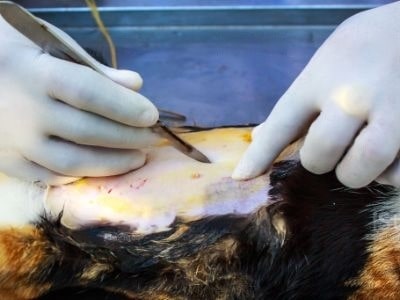
There are two teams for carrying out C-section surgery on dogs. The team will involve experienced vet surgeons and medically trained professionals for assistance. Both teams will have different roles. One team will carry out the procedure and the other is simply for assisting with the tools and post-surgery care.
After the pregnant dog is relaxed on the surgical table on their back, and anesthetised, here is how the surgical team normally operates:
- The fur near the lower abdomen is removed and the skin is cleaned with surgical soap. This will keep the area sterile and a surgical drape is used to avoid contact with the unclean surface and surroundings.
- Afterwards, using the scalpel, the vet will make a ventral midline incision near the lower abdomen region. This incision is identical to the one made during spaying but, relatively longer.
- The incision made will open the abdominal cavity and expose the uterus. Once this exposed uterus is incised, the team can easily get the puppies out. Further, there is a possibility for multiple incisions. This will rely on the number and the size of these pups, and a vet may choose to make more incisions if necessary.
- The puppies are taken out from the first horn of the uterus, then the second horn, and the pups are handed over to the second team for resuscitation. The team has to immediately initiate breathing in the new pups. At times, these newborns may need CPR and it can roughly take about half an hour to make them breathe on their own.
- Once these puppies are delivered, removing the placentas is necessary. Because the removal of the placentas will prevent anoxia.
- Before applying the sutures, the vet will check for lesions, ruptures, or haemorrhages in the uterus. A swab is taken for ensuring there is no infection in the region. The abdominal sutures are self-dissolving but, the outer layer of skin is closed with the surgical staple or sutures and removing them after a couple of weeks is crucial.
Also, during the surgery, the area of the uterus is kept warm. This is done for avoiding hypothermia conditions in dog mothers.
Post-surgery recovery and care
After the completion of the surgery, the medical staff will ensure the female dog receives proper care for a healthy recovery. Also, the vet will only discharge your dog if they feel its condition is healthy and there are no risks for any complications.
- The mother dog will take roughly 5-6 hours to recover from the anaesthesia. During this period it’s crucial to monitor the health of both the mother dog and the pup.
- The effect of anaesthesia is still there and it makes the mother dog weak, so, it’s crucial for the medical staff to remain there. Because it’s possible that the mother dog may unintentionally roll over and crush the newborn pups.
- Once the mother dog wakes up, the medical staff will take the pups and put them near for maternal bonding.
Now, when the vet will feel like the health condition of both mother and the newborn pups is fine, they will allow you to take them home. Also, the vet will provide you with a certain set of instructions for the first few days to ensure there isn’t any health issue or complication with the sutures.
Here are some of the instructions you may get from the vet:
- Provide healthy food and give water continuously every half an hour after the 24 hours of the surgery. However, the quantity should remain less in comparison with the normal diet otherwise, they will vomit.
- Monitor their body temperature, because post-surgery, it’s normal for the mother dog to have some fever. The normal range is 37.8-38.9ºC and if it’s higher for example about 40ºC, visit the vet.
- Newborn pups will need a warm environment, so prepare a specific area where the temperature is slightly high.
- Have backup feeding bottles of milk for the pups. Because it’s possible the pups are not able to feed from their mother for whatever reason.
- Keep the medications for both the mother dogs and the pups.
Risk And Complications Of Having C-section In Dogs
While the surgery may have its benefits and helps the mother dog deliver their pups, there are plenty of risks and complications as well. So, as a dog owner, it’s important you know the potential risks and complications of this procedure.
- Risks for the mother dog
Mother dogs are at risk of facing complications throughout this process. This means before the surgery during the surgery, or afterwards. For instance, they may have a negative reaction to the anaesthesia given before the surgery. This can also happen for any other medication given during this time.
Further, when the surgery begins, they risk getting blood clots, wound infections, and haemorrhaging. Injury to the uterus is also a potential danger and can complicate the operation. At times, the procedure gets too complex and the mother dog doesn’t make it through the surgery and dies on the operating table.
- Risks for the puppies
There is always a risk of a puppy dying because of the C-section procedure. Also, they risk fetal absorption, placental rupture, fetal putrefaction, and malnutrition. While they are taken out, they suffer injuries and their breathing is also compromised. So, some of these newborn pups never breathe even after proper CPR or other medical assistance.
However, one of the main reasons for using C-section surgery is to save the lives of unborn puppies. Hence, not doing the surgery is also a definite risk and puppies or their mother risk dying if not operated on.
FAQs
Is the dog c section good or bad?
Pregnancy is a complex issue, especially in dogs. Also, there are many risk factors involved while deciding whether the dog should have a c-section or not. For instance, the female dog may not survive the surgery or the puppy inside. But, in general, the procedure is considered safe and vets recommend it highly for female dogs who have difficulty in inducing labour.
What is the best time to schedule a c-section for a dog?
A vet will asses the pregnancy of your dog and probably schedule the procedure 63 days from ovulation. This estimation will align with the actual due date for the delivery and the procedure will take place about 24 hours before the due date.
How much is the dog c section cost in the UK?
The surgical procedure is costly and it can cost about £6000 if everything goes as planned. There are additional costs and the bill for the services the hospital or a clinic provides will only rise if your dog is in for a longer stay. However, these high prices are worth it as they cover all the basic necessities such as food, medications, accommodation, medicare and so on.
Are puppies rejected by their mother after a C-section?
Such instances are rare but, they do happen. Many mother dogs may show aggressive behaviour towards their pups after their surgery because the delivery was not natural. Even though the mother dog will bond with the pups afterwards, it’s difficult to anticipate when they will snap and eat their pup. Hence, it becomes crucial to monitor their behaviour even if they seem to have bonded.
How many C-section surgeries can a dog have?
In general, there is no limit to the c-section surgeries a dog can have. Also, there are many health factors that impact the answer to this specific query. Only a vet can present a proper answer that too after analysing the dog’s health condition and the surgical scars left on their body because of the previous surgery. Still, it’s a common suggestion from vets that a dog must not have more than 3 c-sections in their lifetime.
How Much Is a Dog C Section – Final Comment
The normal range a dog owner can anticipate in the UK is £800–£4000. The costs will vary as per the medical institutions or clinics but, it will elevate that for sure. Yes, the c-section surgery of a dog is finished within a couple of hours, but the complexity of the operation is one of the reasons why vets charge high.
Also, there are additional costs such as food, towels, mats etc. after the surgery is finished. Not to forget slightest health issue needs vet consultation and hence, the vet fees. So don’t be surprised if the overall budget surpasses the £5000 mark.
